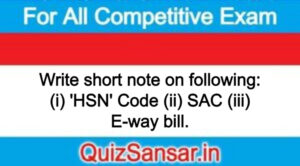
Write short note on following: (i) ‘HSN’ Code (ii) SAC (iii) E-way bill.
Write short note on following: (i) ‘HSN’ Code (ii) SAC (iii) E-way bill.
Ans.
‘Hsn’ Code
The Harmonised Commodity Description and Coding System generally referred to as “Harmonised System of Nomenclature” or simply “HSN” is a multipurpose. international product nomenclature developed by the World Customs Organisation. It comprises about 5,000 commodity groups, each identified by a six-digit code, arranged in a legal and logical structure and is supported by well-defined rules to achieve:
uniform classification. Without HSN, the system will not be able to pick the tax for goods declared at the time of registration.
In case of turnover of less than 1.5 crore, HSN Code is not required to be mentioned. Turnover between 1.5 to 5 crore, 2 digit HSN Code can be used. If turnover is above 5 crore, HSN Code must have 4 digits.
Service Accounting Code (SAC)
As in the case of products or goods, it is essential to identify the services to levy tax based on the type of service. The SAC or Service Accounting Code is used to identify services under GST. In case of services, each service provided is given an unified code for recognition, measurement and taxation. Service will be classified as per SAC issued by Government for service tax. This is same under GST regime also. For example, assume that a hotel provides restaurant services and outdoor catering services. Though both the services may seem to be similar, the rate of tax applicable on restaurant services and outdoor catering services are different. There are different SAC codes for billing of restaurant services and outdoor catering services.
Examples of SAC
SAC Code Name of Service
995411 – Construction services of residential buildings
996421 – Long-distance transport services by Railways, Metro, etc.
996422 – Long-distance transport services through road
996811 – Postal services
997120 – Investment banking services.
E-WAY BILL
Way bill compliance has been a nightmare for suppliers in the pre-GST era. Supply of goods could take place without obtaining these ‘waybills’ from VAT authorities. Way bill was nothing but a physical document that allowed movement of goods, commonly known as BAHATI. The compliance around waybills has caused restricted movement of goods across States. And this one anomaly, GST has rectified.
What is an E-way Bill?
1. E-way Bill is an electronic way bill for movement of goods which can be generated on the GSTN (common portal). A ‘movement’ of goods, more than 50,000 in value cannot be made by a registered person without an E-way Bill.
2. E-way bill will also be allowed to be generated or cancelled through SMS.
3. When an e-way bill is generated before movement of the goods a unique E-way Bill number (EBN) is allocated and is available to the supplier, recipient and the transporter.
4. E-way Bill system has been introduced across the country from 1st April, 2018.
Inspection of Goods in Movement
Information to be furnished prior to the commencement of the movement of goods through the generation of E-way Bill :
Every registered person who causes movement of goods of consignment value exceeding fifty thousand rupees:
(1) In relation to a supply; or
(2) For reasons other than supply; or
(3) Due to inward supply from an unregistered person,
shall, before the commencement of movement, furnish information relating to the said goods in Part A of FORM GST INS-01, electronically. on the common portal, called E-way Bill.






